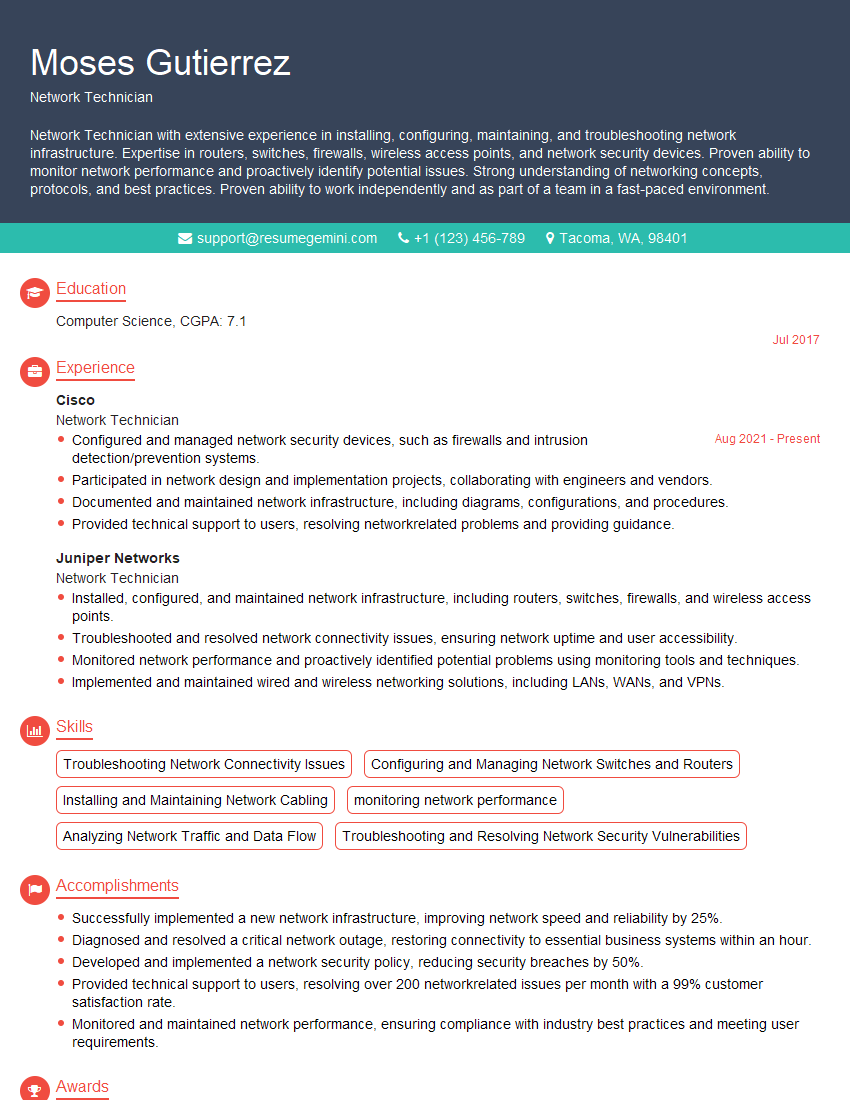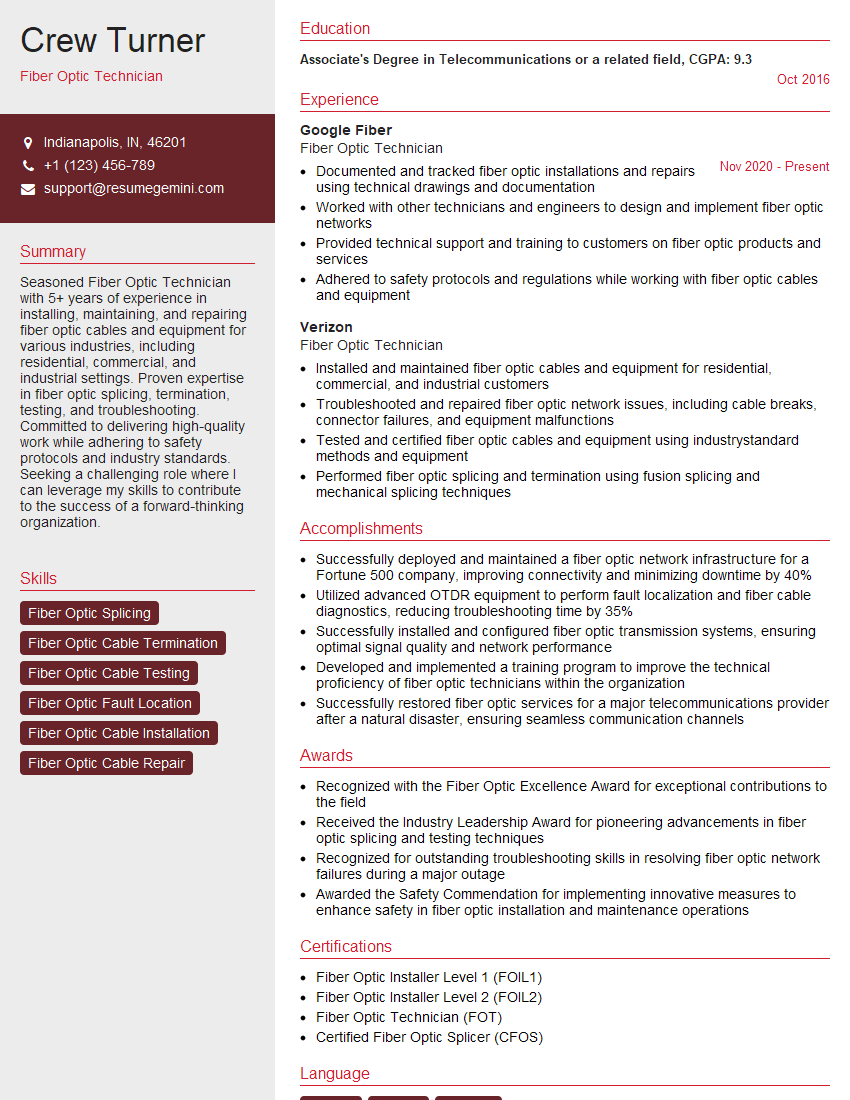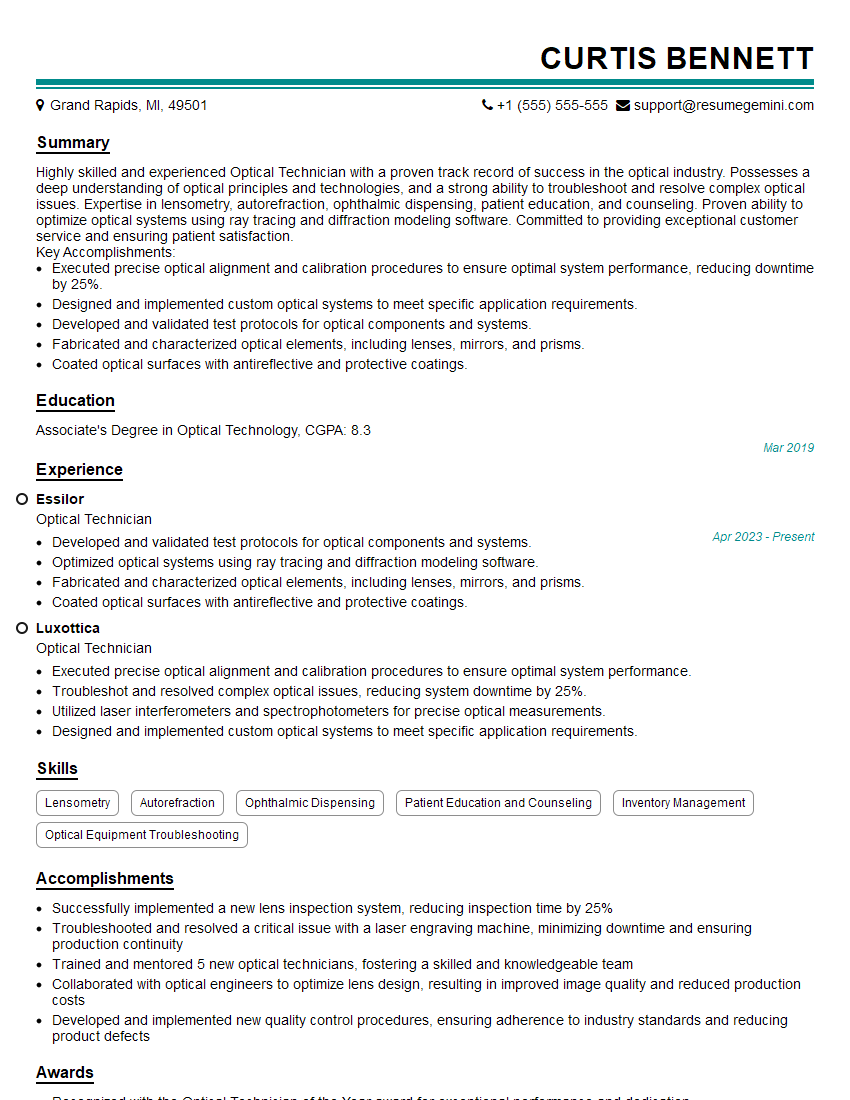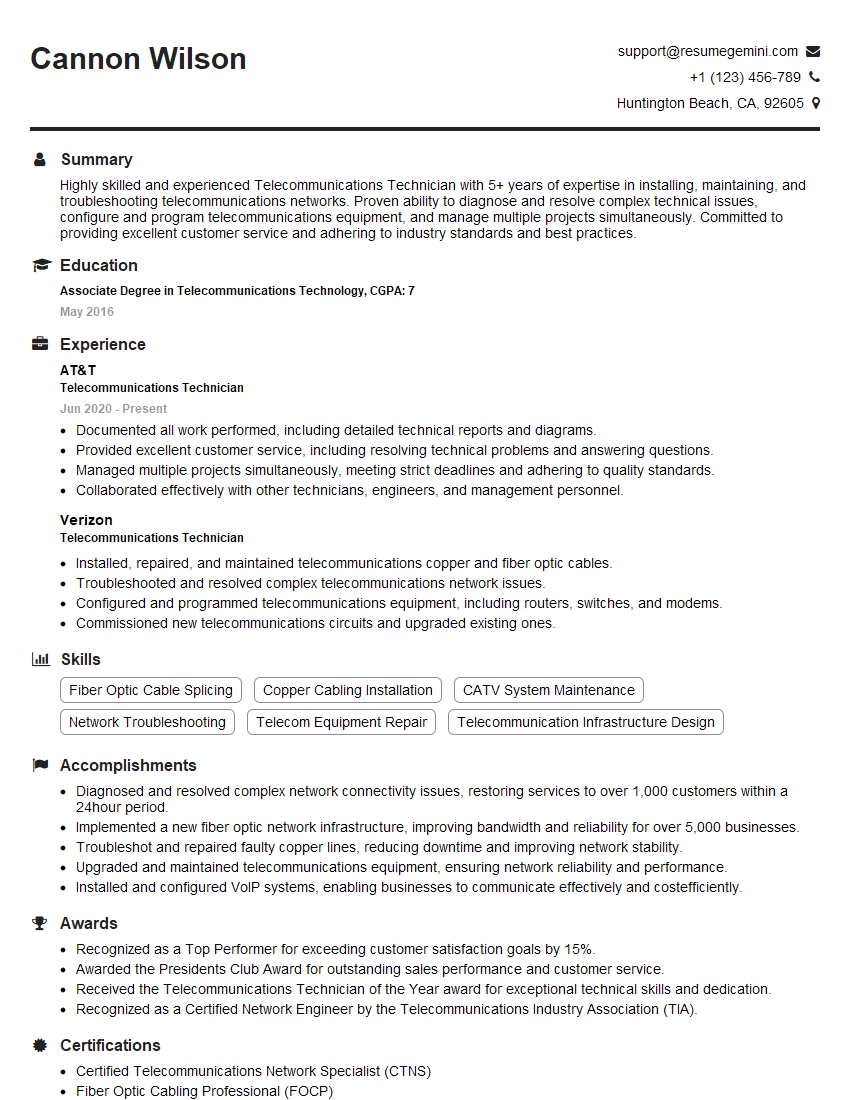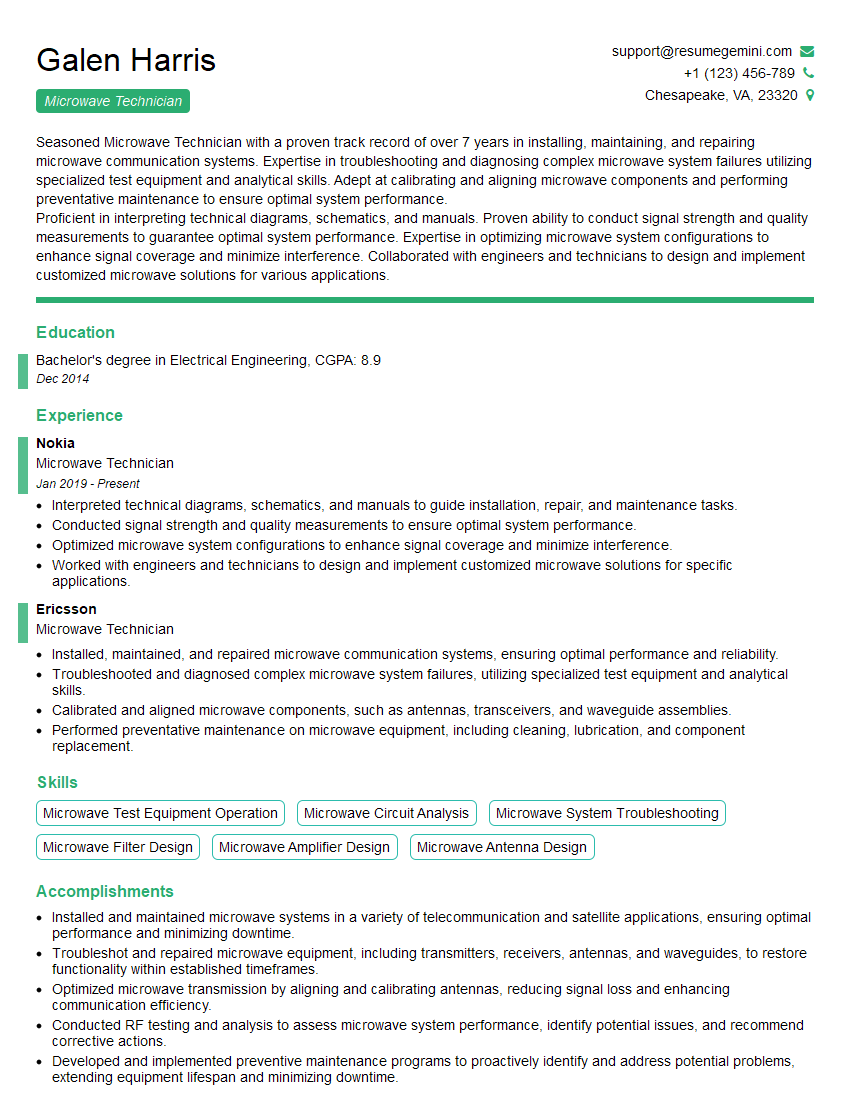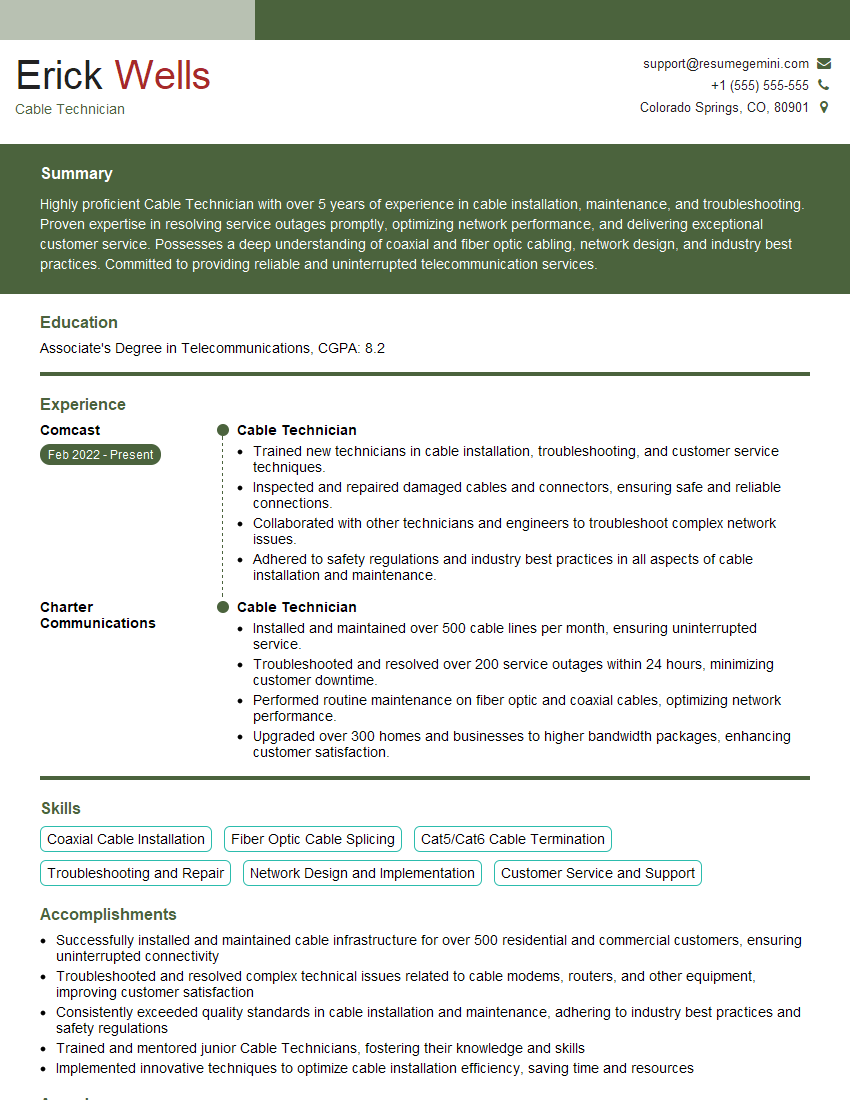Unlock your full potential by mastering the most common Telecommunications Equipment Troubleshooting and Repair interview questions. This blog offers a deep dive into the critical topics, ensuring you’re not only prepared to answer but to excel. With these insights, you’ll approach your interview with clarity and confidence.
Questions Asked in Telecommunications Equipment Troubleshooting and Repair Interview
Q 1. Describe your experience troubleshooting VoIP systems.
Troubleshooting VoIP systems involves a systematic approach, combining network diagnostics with understanding the specifics of voice-over-IP protocols. I begin by identifying the nature of the problem: is it affecting all users, just one? Is it a complete outage or poor call quality (jitter, latency, packet loss)?
My process typically involves these steps:
- Network Connectivity Checks: Pinging the VoIP server and gateway, checking for network congestion using tools like Wireshark (to capture and analyze network traffic), and examining network devices for errors or misconfigurations (routers, switches).
- VoIP-Specific Diagnostics: Utilizing tools that analyze RTP (Real-time Transport Protocol) streams, analyzing Quality of Service (QoS) settings on the network to ensure priority is given to VoIP traffic. I would also examine the SIP (Session Initiation Protocol) message logs for errors or call setup failures.
- Codec Issues: VoIP uses codecs (coders-decoders) to compress and decompress voice data. Issues with codec compatibility or configuration can lead to poor audio quality. Troubleshooting this often involves checking the settings on both the client and server side.
- Hardware Issues: A faulty VoIP phone or network interface card (NIC) can be the source of the problem. I’d check for physical damage, test with different hardware if available, and examine device logs for errors.
For example, I once resolved a widespread VoIP outage by identifying a misconfigured QoS policy on the core router that was prioritizing non-critical traffic over VoIP, resulting in excessive latency and dropped calls. The solution was a simple policy adjustment, restoring service for all users.
Q 2. How do you diagnose intermittent network connectivity issues?
Diagnosing intermittent network connectivity issues requires a methodical approach, eliminating possibilities systematically. These problems are notoriously difficult because they are, by definition, not consistent.
My strategy focuses on:
- Gathering Information: I begin by asking questions to understand the pattern: When do these issues occur? How long do they last? What specific applications or devices are affected?
- Network Monitoring: Employing network monitoring tools like PRTG, Nagios, or SolarWinds to observe network performance metrics (packet loss, latency, jitter, throughput) during both problem and normal periods. This can reveal patterns that the user might not have noticed.
- Troubleshooting Tools: I would use tools like ping, tracert (or traceroute), and nslookup to analyze path and connectivity to critical network resources. If wireless is involved, signal strength and interference need investigation.
- Hardware Inspection: Examining cables, connectors, and network devices for physical damage or loose connections. In some cases, intermittent failures are caused by loose or failing components.
- Software and Configuration Review: Checking network device configurations (routers, switches, firewalls) for misconfigurations, and looking for software updates or driver issues that could be causing instability.
Imagine a scenario where a user experiences intermittent connectivity only during peak hours. Network monitoring tools might reveal network congestion during those periods, pointing to the need for network upgrades or traffic shaping.
Q 3. Explain the process of testing a fiber optic cable.
Testing fiber optic cables involves verifying both the physical integrity of the cable and the quality of the optical signal transmitted through it. This requires specialized equipment.
The process typically includes:
- Visual Inspection: A thorough visual inspection of the cable and connectors for any physical damage, such as scratches, bends, or cracks. Fiber is fragile and even microscopic flaws can cause signal issues.
- Optical Power Meter (OPM): An OPM measures the optical power level at various points along the fiber cable. This helps identify signal loss due to attenuation or other factors.
- Optical Time-Domain Reflectometer (OTDR): This is a critical tool, creating a visual representation of the fiber cable. It can pinpoint the location of breaks, splices, or connectors with high loss. It’s essentially a very powerful ‘fiber cable scanner’.
- Fiber Connector Inspection: Microscopic inspection of fiber connector end faces (using a connector inspection scope) is crucial. Even small amounts of dust, debris, or scratches can significantly affect signal quality.
- Loss Budget Calculation: Before installing a fiber system, engineers calculate a loss budget to define the acceptable amount of signal loss within the network. Testing verifies the network stays within this budget.
For example, using an OTDR, I once located a micro-bend in a fiber cable deep within a building’s infrastructure that was causing intermittent outages. This was only detectable through OTDR testing. Replacing the section resolved the issue.
Q 4. What are common causes of signal degradation in RF systems?
Signal degradation in RF (radio frequency) systems can stem from various factors, all ultimately causing a reduction in signal strength or quality. Think of it like a whisper getting fainter the further it travels.
Common causes include:
- Attenuation: Signal strength naturally weakens with distance. The longer the signal travels, the greater the attenuation.
- Multipath Propagation: Signals can bounce off objects (buildings, trees) before reaching the receiver, resulting in interference and fading.
- Atmospheric Interference: Weather conditions such as rain, snow, or fog can absorb or scatter RF signals.
- Interference from other signals: Signals from other devices operating on similar frequencies can interfere with the desired signal (co-channel interference).
- Noise: Various sources, such as electrical equipment, can introduce noise into the RF signal, reducing its clarity.
- Cable Degradation: Damaged or poorly shielded coaxial cables can cause signal loss and interference.
- Equipment Malfunctions: Faulty transmitters or receivers can also contribute to signal degradation.
A real-world example: I once worked on a case where poor WiFi performance was traced back to interference from a nearby microwave oven. The oven’s radiation, although unintentional, was degrading the WiFi signal quality significantly.
Q 5. How would you troubleshoot a faulty DSL connection?
Troubleshooting a faulty DSL (Digital Subscriber Line) connection involves a systematic process, working from the user’s equipment to the DSLAM (Digital Subscriber Line Access Multiplexer) at the telephone company’s central office.
My approach involves:
- Check the physical connection: Begin by checking the DSL modem for proper connection to the phone line. Inspect for loose connections or damaged cables.
- Test the line quality: Use a DSL line tester to check the signal strength and noise levels. High noise levels or low signal strength indicate problems with the phone line.
- Check the DSL modem: Power cycle the modem and check its diagnostic lights. Many modems provide detailed diagnostic information.
- Check for ISP issues: Contact your Internet Service Provider (ISP) to see if there are any known outages or network issues affecting the area.
- Check for interference: DSL lines can be sensitive to interference from other devices. Check for noise sources such as old phone systems or improperly grounded wiring.
- Check splitter configuration: Many DSL setups employ splitters to separate voice and data signals. Incorrect splitter configurations can cause connectivity problems.
For instance, a seemingly inexplicable DSL outage might be caused by a faulty splitter. Replacing the splitter is a quick, inexpensive solution that can easily resolve the issue.
Q 6. What tools and equipment do you use for telecom equipment repair?
My toolbox for telecom equipment repair is diverse, adapting to the specific technology being addressed. It includes:
- Multimeters: For measuring voltage, current, and resistance in various circuits.
- Oscilloscope: To examine the waveforms of electrical signals and identify anomalies.
- Spectrum Analyzer: For analyzing the frequency spectrum of RF signals, identifying interference or signal impairments.
- Protocol Analyzers (e.g., Wireshark): To capture and analyze network traffic, troubleshooting data communication problems.
- Optical Power Meters and OTDRs: As described earlier, for fiber optic cable testing.
- Cable Testers: For verifying the integrity of copper cabling and locating faults.
- Specialized Tools: Specific tools for certain technologies such as T1/E1 test sets or VoIP protocol analyzers.
- Hand Tools: Basic hand tools like screwdrivers, pliers, and wire strippers are essential.
Beyond tools, having access to manufacturer documentation, schematics, and software is crucial for effective repair.
Q 7. Explain your experience with T1/E1 lines and their troubleshooting.
T1/E1 lines are digital leased lines providing high-bandwidth connectivity, often used for business applications. Troubleshooting these lines requires expertise in digital transmission technologies.
My experience includes:
- Understanding Line Signaling: T1 and E1 lines utilize specific signaling protocols (e.g., framing, bit-stuffing). Troubleshooting often involves examining these signals for errors or loss of synchronization.
- Using Test Equipment: Specialized T1/E1 test sets are used to analyze line quality, detect errors, and locate faults. These sets measure things like bit error rate (BER), signal-to-noise ratio (SNR), and jitter.
- Identifying Faults: Problems can range from simple cable issues or connector problems to more complex issues in the network equipment at the central office or customer premises. Troubleshooting often involves tracing the signal path from end-to-end.
- Working with Carriers: T1/E1 line troubleshooting often requires coordination with the carrier to isolate problems within their network.
In one instance, I pinpointed an intermittent T1 line outage to a failing fiber optic splice in the carrier’s network by analyzing the error patterns and coordinating with their engineering team. The coordinated effort resulted in efficient repair with minimal disruption to service.
Q 8. Describe your knowledge of different types of network topologies.
Network topologies describe the physical or logical layout of a network. Understanding them is crucial for troubleshooting because the topology directly impacts how data flows and where problems might occur. There are several common types:
- Bus Topology: Imagine a single highway (the bus) where all devices are connected. A break anywhere on the highway disrupts the entire network. Simple but less reliable for larger networks.
- Star Topology: This is the most common type, like a wheel with a central hub (often a switch or router) and devices connected as spokes. A problem with one device generally doesn’t affect others. Easy to manage and expand.
- Ring Topology: Data flows in a circle from device to device. A break anywhere interrupts the flow. Requires more sophisticated error detection and recovery mechanisms.
- Mesh Topology: Multiple interconnected paths between devices. Redundancy is built-in, making it very reliable but more complex and expensive to implement. Often used in critical infrastructure.
- Tree Topology: A hierarchical structure, often used in larger networks combining elements of star and bus topologies. Think of branches extending from a main trunk.
Knowing the topology helps pinpoint the potential source of an issue. For example, in a star topology, a single failing device is easily isolated, while in a bus topology, a fault might require more extensive investigation.
Q 9. How do you prioritize multiple repair requests?
Prioritizing repair requests involves a combination of factors. I use a system that considers:
- Impact: How many users or services are affected? A widespread outage needs immediate attention over a single user issue.
- Severity: Is it a complete failure or a minor degradation? A complete network outage takes precedence over slow internet speeds.
- Urgency: Are there service level agreements (SLAs) in place? Meeting those contractual obligations is paramount.
- Dependencies: Does resolving one issue depend on fixing another? This requires a strategic approach, potentially addressing interdependent problems concurrently.
I use a ticketing system that allows for assigning priority levels (e.g., critical, high, medium, low) and tracking progress. This ensures transparency and accountability. For example, a critical outage affecting a critical business system would always get precedence over a low-priority issue with a less critical system.
Q 10. How familiar are you with network protocols (e.g., TCP/IP, UDP)?
I’m very familiar with network protocols, particularly TCP/IP and UDP. They form the backbone of most communication over the internet and within networks.
- TCP/IP (Transmission Control Protocol/Internet Protocol): This is a connection-oriented protocol, meaning it establishes a connection before transmitting data and ensures reliable delivery. Think of it as sending a registered letter – you know it’s arrived. It’s used for applications requiring reliable data transfer, like web browsing (HTTP) and email (SMTP).
- UDP (User Datagram Protocol): This is a connectionless protocol, meaning it doesn’t establish a connection before sending data. It’s faster but doesn’t guarantee delivery. Think of it as sending a postcard – you hope it arrives, but there’s no confirmation. It’s used in applications where speed is prioritized over reliability, such as online gaming and video streaming.
Understanding these protocols is crucial for troubleshooting network connectivity problems. For instance, if a web page doesn’t load, I’d investigate TCP/IP related issues like port access, firewalls, or routing problems. If a video stream is buffering frequently, I’d look at UDP packet loss or network congestion.
Q 11. Explain your experience with different types of cabling (e.g., CAT5e, CAT6).
I have extensive experience with various cabling types, primarily CAT5e and CAT6. These are twisted-pair cables used for Ethernet networks, differing primarily in bandwidth and performance capabilities.
- CAT5e (Category 5 Enhanced): Supports Gigabit Ethernet speeds (1000 Mbps) up to 100 meters. It’s a cost-effective option for many applications.
- CAT6 (Category 6): Supports Gigabit Ethernet speeds and also higher bandwidths (10 Gigabit Ethernet) up to 100 meters. It offers improved noise immunity and signal integrity compared to CAT5e, making it suitable for higher-speed networks and longer distances.
Proper cabling is essential. Problems can arise from incorrect termination (crimping), damaged cables, or poor connections. My troubleshooting involves checking for continuity, signal integrity (using a cable tester), and proper termination. I’ve encountered situations where a seemingly minor nick in the cable caused intermittent network issues, highlighting the importance of quality installation and inspection.
Q 12. How do you document your troubleshooting process and repair solutions?
Documentation is crucial for effective troubleshooting and maintaining a history of repairs. I use a comprehensive approach, including:
- Ticketing System: Detailed records of all issues, steps taken, solutions implemented, and associated times. This system allows for tracking and reporting.
- Network Diagrams: Visual representations of the network layout, making it easier to identify affected areas and trace the flow of data.
- Test Results: Records of ping tests, traceroute results, cable tester readings, etc., providing objective evidence of the problem and the solution’s effectiveness.
- Configuration Files: Before making changes, I always backup configurations. This allows for reverting changes if necessary. I also document all configuration modifications made.
Thorough documentation enables faster resolution of recurring issues and helps others understand the repair history of equipment. It also serves as a valuable resource for future maintenance and upgrades.
Q 13. Describe your experience with power supply issues in telecom equipment.
Power supply issues are a common cause of telecom equipment failure. Troubleshooting these problems requires a systematic approach, starting with safety precautions:
- Safety First: Always disconnect power before working on equipment. Ensure proper grounding and use appropriate safety equipment.
- Visual Inspection: Check for obvious signs of damage such as burnt components, loose connections, or physical damage to the power supply unit.
- Voltage and Current Measurement: Use a multimeter to verify the input and output voltages and currents of the power supply. Compare the readings to the specifications to identify any deviations.
- Testing Power Supply Components: If necessary and with appropriate expertise, individual components within the power supply (capacitors, rectifiers) can be tested to isolate the faulty part.
- Environmental Factors: Consider environmental factors like overheating which might damage components over time.
I’ve experienced cases where a faulty power cord caused seemingly random equipment failures. This highlights the importance of examining even the simplest components. A comprehensive approach ensures identifying and resolving the root cause, preventing further damage and downtime.
Q 14. How do you identify and resolve problems with network routing?
Network routing problems can manifest as connectivity issues, slow speeds, or inability to reach certain destinations. Resolving them involves several steps:
- Traceroute/Tracert: This command-line tool traces the path packets take to reach a destination, identifying potential bottlenecks or faulty routers along the way.
tracert google.com - Ping Tests: A simple test to check network connectivity to a specific IP address. Successful pings indicate basic connectivity, while failures pinpoint a connectivity problem.
ping 8.8.8.8 - Routing Table Inspection: Examining the routing tables on routers and switches reveals which routes are used and identifies possible misconfigurations. Incorrect routing entries could redirect traffic to a non-existent or unreachable network.
- Network Monitoring Tools: Advanced tools provide detailed network performance data, helping identify patterns and anomalies that might indicate routing problems.
- Check for BGP (Border Gateway Protocol) issues (if applicable): In larger networks BGP is responsible for routing between different autonomous systems. Problems here can cause larger scale outages
For example, a traceroute showing a packet loss at a particular router suggests a problem with that router. I would then investigate that router’s configuration, logs and physical status. Combining these techniques allows for a methodical and effective resolution of network routing issues.
Q 15. What is your experience with remote diagnostics and troubleshooting?
Remote diagnostics and troubleshooting are crucial in today’s telecom landscape. My experience spans several years, encompassing the use of various remote access tools and techniques to identify and resolve issues on a wide array of telecommunications equipment. This includes utilizing tools like secure shell (SSH), Telnet (though less frequently due to security concerns), and various vendor-specific management interfaces. I’m proficient in interpreting logs, analyzing performance metrics, and remotely configuring devices to restore service. For example, I once remotely diagnosed and resolved a significant service outage at a remote cell tower by analyzing network logs and identifying a faulty power supply – all without physically visiting the site, saving the company significant time and resources. I also have experience using out-of-band management tools for troubleshooting even when the primary network connection is down.
Career Expert Tips:
- Ace those interviews! Prepare effectively by reviewing the Top 50 Most Common Interview Questions on ResumeGemini.
- Navigate your job search with confidence! Explore a wide range of Career Tips on ResumeGemini. Learn about common challenges and recommendations to overcome them.
- Craft the perfect resume! Master the Art of Resume Writing with ResumeGemini’s guide. Showcase your unique qualifications and achievements effectively.
- Don’t miss out on holiday savings! Build your dream resume with ResumeGemini’s ATS optimized templates.
Q 16. Explain your understanding of OSI model and its layers.
The OSI (Open Systems Interconnection) model is a conceptual framework that standardizes the functions of a telecommunication or computing system without regard to its underlying internal structure and technology. It’s organized into seven layers, each with specific responsibilities:
- Layer 1 (Physical): Deals with the physical transmission of data, like cables and connectors.
- Layer 2 (Data Link): Handles data framing, error detection (e.g., using CRC checksums), and MAC addressing (like Ethernet).
- Layer 3 (Network): Handles routing of packets between networks using IP addresses.
- Layer 4 (Transport): Provides reliable end-to-end data transfer, managing segmentation and reassembly (TCP) or connectionless data transmission (UDP).
- Layer 5 (Session): Manages connections between applications, handling session establishment and termination.
- Layer 6 (Presentation): Handles data formatting and encryption/decryption.
- Layer 7 (Application): Provides network services to applications (e.g., HTTP, FTP).
Understanding the OSI model is fundamental to troubleshooting network issues. By isolating the layer where the problem originates, you can significantly narrow down the potential causes. For example, if a ping fails, the problem likely resides in layers 1, 2, or 3. If a web page won’t load, you might need to investigate layers 4-7.
Q 17. Describe your experience with various network monitoring tools.
My experience with network monitoring tools is extensive. I’m proficient with tools like SolarWinds, Nagios, and PRTG for network performance monitoring, fault management, and capacity planning. These tools provide real-time visibility into network health, allowing for proactive identification of potential problems. I also utilize protocol analyzers like Wireshark to capture and analyze network traffic, helping pinpoint specific issues at the packet level. For example, using Wireshark, I once identified a specific faulty configuration on a router causing packet loss resulting in slowdowns on a specific VoIP service.
Furthermore, I’m familiar with SNMP (Simple Network Management Protocol) and its use in collecting data from network devices. This includes configuring SNMP traps for immediate alerts on critical events. This proactive approach allows for quicker resolution of problems before they impact end users.
Q 18. How do you handle escalated issues or complex problems?
When handling escalated issues or complex problems, I follow a structured approach. First, I thoroughly document the problem, gathering all relevant information like error messages, logs, and performance metrics. Then, I systematically analyze the available data, identifying potential root causes. This may involve consulting technical documentation, collaborating with other engineers, or escalating the issue to relevant vendors. I’ll also create a plan, outlining the steps required to resolve the problem, keeping stakeholders informed of progress. A recent example involved a major network outage. I worked collaboratively with the team, utilizing network monitoring tools and packet analysis, to quickly isolate the cause – a faulty fiber optic cable – and implemented a solution which included a temporary rerouting solution and then the replacement of the faulty cable, effectively restoring services and preventing further disruption.
Q 19. What is your experience with preventative maintenance on telecom equipment?
Preventative maintenance is key to ensuring the reliability and longevity of telecommunications equipment. My experience includes developing and implementing preventative maintenance plans for various equipment, including routers, switches, and cell towers. These plans typically include regular inspections, software updates, firmware upgrades, and environmental checks (temperature, humidity, power). I also employ automated monitoring tools that alert us to potential issues before they become major problems. This proactive approach has consistently reduced downtime and minimized costly repairs. For example, a scheduled firmware upgrade on a set of core switches prevented a known vulnerability from being exploited. This preemptive approach saved us from potentially significant network disruption and security breach.
Q 20. Explain your familiarity with different types of switching equipment.
I’m familiar with various types of switching equipment, including:
- Circuit-switched: Traditional phone systems that establish a dedicated path for the duration of a call (e.g., older PBX systems).
- Packet-switched: Networks that break data into packets, routing them through various paths (e.g., routers and Ethernet switches).
- Time-division multiplexing (TDM): A technique for sharing a single channel among multiple users by dividing time slots.
- Frequency-division multiplexing (FDM): Shares a channel by assigning different frequency bands to different users.
- IP-based switches: Modern switches using the internet protocol to route and forward data. These are commonly found in modern data centers and enterprise networks.
My experience includes working with both legacy and modern switching systems, understanding their strengths and limitations. This knowledge allows me to adapt to different environments and effectively troubleshoot issues within various switching architectures.
Q 21. How would you troubleshoot a problem with a faulty modem?
Troubleshooting a faulty modem involves a systematic approach. First, I’d verify the obvious: power is connected and the modem’s lights are indicating a connection to the service provider. If the lights indicate a problem, I’d check the cabling (both the power cord and the connection to the wall outlet or network). Next, I’d check the modem’s configuration, ensuring the correct settings for the service provider are in place. If the modem’s diagnostics show no issues but there’s still no internet access, I’d move to the next level of troubleshooting: checking the router (if one is present), making sure it’s configured correctly. I’d also test the internet connection using a different device to isolate whether the problem is with the modem or another part of the network. If the problem persists, I’d check the internet service itself by contacting the provider. Finally, a factory reset of the modem is usually done as a last resort, if it is not working correctly. Often, a simple reboot of the modem is enough to resolve temporary glitches.
Q 22. Describe your experience with different types of antennas and their applications.
My experience encompasses a wide range of antenna types, each with specific applications. Think of antennas like specialized microphones and speakers for radio waves. Different frequencies and environments demand different designs.
Yagi-Uda antennas: These directional antennas are highly effective for point-to-point links, like connecting two cell towers or providing long-range Wi-Fi. Their gain is high, meaning they focus the signal in a specific direction, resulting in better performance, especially in noisy environments. I’ve used these extensively in rural deployments to extend network coverage.
Patch antennas: These low-profile antennas are commonly found in cellular base stations and Wi-Fi access points. They are less directional than Yagi-Uda antennas, providing wider coverage but with less gain. I’ve worked with several designs, optimizing their placement for optimal building coverage in urban settings.
Omni-directional antennas: These antennas radiate signals in all directions, making them ideal for applications where coverage is crucial, such as broadcasting radio signals or providing Wi-Fi in a home. I’ve troubleshot many instances where poor omni-antenna placement led to signal dead zones within a building.
Microstrip antennas: These are integrated circuit antennas commonly used in mobile devices, offering a compact size ideal for integration into handheld equipment. Diagnosing issues with these antennas often involved careful testing for impedance matching and ensuring correct grounding.
Choosing the right antenna is critical for optimal signal quality. Factors like frequency band, gain, beamwidth, and environmental conditions must be considered. I’ve had to troubleshoot situations where an incorrectly chosen antenna was causing significant performance degradation.
Q 23. How do you stay updated with the latest technologies in telecommunications?
Staying current in telecommunications is vital. I employ a multi-faceted approach:
Industry Publications and Journals: I regularly read publications like IEEE Communications Magazine and other industry-specific journals to stay informed on the latest research and technological advancements.
Conferences and Workshops: Attending conferences like those hosted by organizations such as the IEEE and attending vendor-specific training sessions allows me to network and learn about new equipment and technologies directly from experts. I recently attended a workshop focused on 5G deployment strategies.
Online Courses and Webinars: Platforms like Coursera and edX offer many valuable courses on telecommunication technologies, and vendors often host webinars on their latest products and features.
Vendor Documentation and Support: I leverage vendor documentation and support resources to familiarize myself with new equipment and software updates.
Professional Networking: Engaging with colleagues and industry professionals through online forums and professional organizations keeps me updated on real-world challenges and solutions.
This proactive approach ensures I remain competent and efficient in troubleshooting and repairing the latest telecommunications equipment.
Q 24. How do you ensure the security of the telecom equipment you maintain?
Security is paramount in telecommunications. My approach involves a layered strategy:
Physical Security: Ensuring equipment is housed in secure locations, with access control and surveillance, is crucial. This includes properly securing rack-mounted equipment and monitoring access points. I’ve implemented various physical security measures in numerous installations.
Network Security: Implementing robust firewalls, intrusion detection systems, and regular security audits are vital. Properly configuring network devices to secure network protocols is crucial. I’ve been directly involved in security hardening for numerous networks, focusing on identifying and mitigating vulnerabilities.
Software Security: Keeping software updated with the latest security patches and employing strong passwords and access controls are essential. We often use secure remote access solutions for management and troubleshooting, minimizing risks associated with direct physical access.
Regular Audits and Assessments: Performing regular security audits and vulnerability assessments helps identify weaknesses and ensure the systems remain secure.
Security is not a one-time task but an ongoing process. I’ve been involved in several incidents requiring immediate security response and remediation, highlighting the importance of proactive security measures.
Q 25. Describe your experience working with different telecommunication vendors’ equipment.
My experience spans various vendors including Cisco, Juniper, Huawei, and Ericsson. Each vendor has its unique approach to equipment design, software, and management. The key to effective troubleshooting across vendors lies in understanding fundamental networking principles and having a systematic approach to diagnosing issues. For example, while the command structure for configuring routing protocols might differ slightly between Cisco and Juniper devices, the underlying concepts of routing table management and protocol behavior remain constant.
I’ve successfully troubleshot problems ranging from faulty hardware components to software misconfigurations across these platforms. This often involved consulting vendor-specific documentation, leveraging online resources, and engaging with their support teams when necessary.
Q 26. What is your experience with IP addressing and subnetting?
IP addressing and subnetting are fundamental to networking. I’m proficient in designing and implementing IP addressing schemes, including IPv4 and IPv6. Understanding subnetting allows me to efficiently allocate IP addresses within a network, maximizing the utilization of available address space.
For instance, I’ve designed subnets for large organizations, ensuring efficient address allocation for various departments and services. I’ve also had to troubleshoot IP addressing conflicts, which often involved using tools like ping and traceroute to locate the source of the problem and reconfigure the IP scheme accordingly.
My experience also includes working with VLSM (Variable Length Subnet Masking) to optimize subnet sizes based on network requirements, improving efficiency and reducing address waste. Understanding CIDR notation (e.g., 192.168.1.0/24) is critical for effective network planning and troubleshooting.
Q 27. How do you ensure compliance with industry standards and regulations?
Compliance with industry standards and regulations is critical in telecommunications. My experience includes working with standards such as those defined by the IEEE, 3GPP, and relevant regulatory bodies. This involves understanding the specific requirements for different types of equipment and services, and ensuring that all systems and processes adhere to these standards.
For example, I’ve ensured compliance with regulations around electromagnetic interference (EMI), ensuring that equipment meets the required emission limits. We also follow strict procedures for handling and disposing of hazardous materials, complying with relevant environmental regulations. Maintaining detailed documentation of all work performed is crucial for compliance audits.
Regular training and staying updated on the latest regulatory changes are essential aspects of maintaining compliance.
Q 28. Explain your problem-solving approach when dealing with unexpected technical challenges.
My problem-solving approach is systematic and methodical. I follow a structured process:
Identify the Problem: The first step involves precisely defining the problem. This often includes gathering information from users, monitoring system logs, and performing initial diagnostics. For example, a user reporting intermittent connectivity issues would require me to determine the nature of the problem—is it a network issue, a hardware issue, or something else?
Gather Information: Collect all relevant data. This might involve checking network performance metrics, examining system logs, and conducting physical inspections of equipment. Tools like network analyzers and protocol debuggers are invaluable at this stage.
Formulate Hypotheses: Based on the gathered information, I develop several potential hypotheses to explain the problem. For instance, if a cell tower has low signal strength, hypotheses might include antenna misalignment, faulty hardware, or interference from other sources.
Test Hypotheses: Systematically test each hypothesis, often involving a process of elimination. For example, if antenna misalignment is suspected, I’d physically inspect and adjust it.
Implement Solution: Once the root cause is identified, I implement the appropriate solution. This could range from replacing a faulty component to reconfiguring network settings.
Verify Solution: After implementing a solution, I thoroughly verify that the problem has been resolved and that the system is operating correctly. This often includes ongoing monitoring to ensure stability.
Document Findings: Maintaining detailed records of the problem, the troubleshooting steps, and the solution is crucial for future reference and for knowledge sharing.
This methodical approach, coupled with my experience and knowledge of telecommunications systems, allows me to efficiently resolve a wide range of technical challenges.
Key Topics to Learn for Telecommunications Equipment Troubleshooting and Repair Interview
- Network Fundamentals: Understanding basic networking concepts like TCP/IP, OSI model, routing protocols (e.g., BGP, OSPF), and subnetting is crucial for diagnosing network issues within telecommunications systems.
- Troubleshooting methodologies: Mastering systematic troubleshooting techniques, including the use of diagnostic tools, logs analysis, and fault isolation procedures, is vital for efficient problem-solving.
- Hardware Knowledge: Develop a solid understanding of various telecommunications hardware components, such as routers, switches, optical transceivers, and multiplexers, including their functionality and potential failure points.
- Software and Firmware: Familiarize yourself with common telecommunications software and firmware used in network management and device configuration. Be prepared to discuss updates, patches, and version compatibility.
- Fiber Optics: Gain practical knowledge of fiber optic cable testing, troubleshooting signal degradation, and identifying common fiber optic issues.
- Wireless Technologies: Understand different wireless communication protocols (e.g., Wi-Fi, cellular) and their potential points of failure. This includes understanding signal strength, interference, and coverage.
- Security: Discuss common security threats in telecommunications networks and the measures taken to mitigate them. This includes knowledge of firewalls, intrusion detection systems, and access control.
- Documentation and Reporting: Learn to clearly and concisely document troubleshooting steps, findings, and solutions. Effective reporting is key to efficient communication within a team.
- Safety Procedures: Demonstrate understanding of safety regulations and best practices when working with telecommunications equipment.
- Problem-solving and analytical skills: Be ready to discuss your approach to complex problems and your ability to think critically and systematically to find solutions.
Next Steps
Mastering Telecommunications Equipment Troubleshooting and Repair opens doors to a rewarding career with excellent growth potential. You’ll be highly sought after by companies needing skilled technicians to maintain the critical infrastructure of our connected world. To maximize your job prospects, crafting an ATS-friendly resume is paramount. This ensures your skills and experience are effectively highlighted to potential employers. We highly recommend using ResumeGemini to build a professional, impactful resume. ResumeGemini provides a streamlined process and offers examples of resumes tailored to Telecommunications Equipment Troubleshooting and Repair, helping you present your qualifications in the best possible light.
Explore more articles
Users Rating of Our Blogs
Share Your Experience
We value your feedback! Please rate our content and share your thoughts (optional).
What Readers Say About Our Blog
Hello,
We found issues with your domain’s email setup that may be sending your messages to spam or blocking them completely. InboxShield Mini shows you how to fix it in minutes — no tech skills required.
Scan your domain now for details: https://inboxshield-mini.com/
— Adam @ InboxShield Mini
Reply STOP to unsubscribe
Hi, are you owner of interviewgemini.com? What if I told you I could help you find extra time in your schedule, reconnect with leads you didn’t even realize you missed, and bring in more “I want to work with you” conversations, without increasing your ad spend or hiring a full-time employee?
All with a flexible, budget-friendly service that could easily pay for itself. Sounds good?
Would it be nice to jump on a quick 10-minute call so I can show you exactly how we make this work?
Best,
Hapei
Marketing Director
Hey, I know you’re the owner of interviewgemini.com. I’ll be quick.
Fundraising for your business is tough and time-consuming. We make it easier by guaranteeing two private investor meetings each month, for six months. No demos, no pitch events – just direct introductions to active investors matched to your startup.
If youR17;re raising, this could help you build real momentum. Want me to send more info?
Hi, I represent an SEO company that specialises in getting you AI citations and higher rankings on Google. I’d like to offer you a 100% free SEO audit for your website. Would you be interested?
Hi, I represent an SEO company that specialises in getting you AI citations and higher rankings on Google. I’d like to offer you a 100% free SEO audit for your website. Would you be interested?
good
